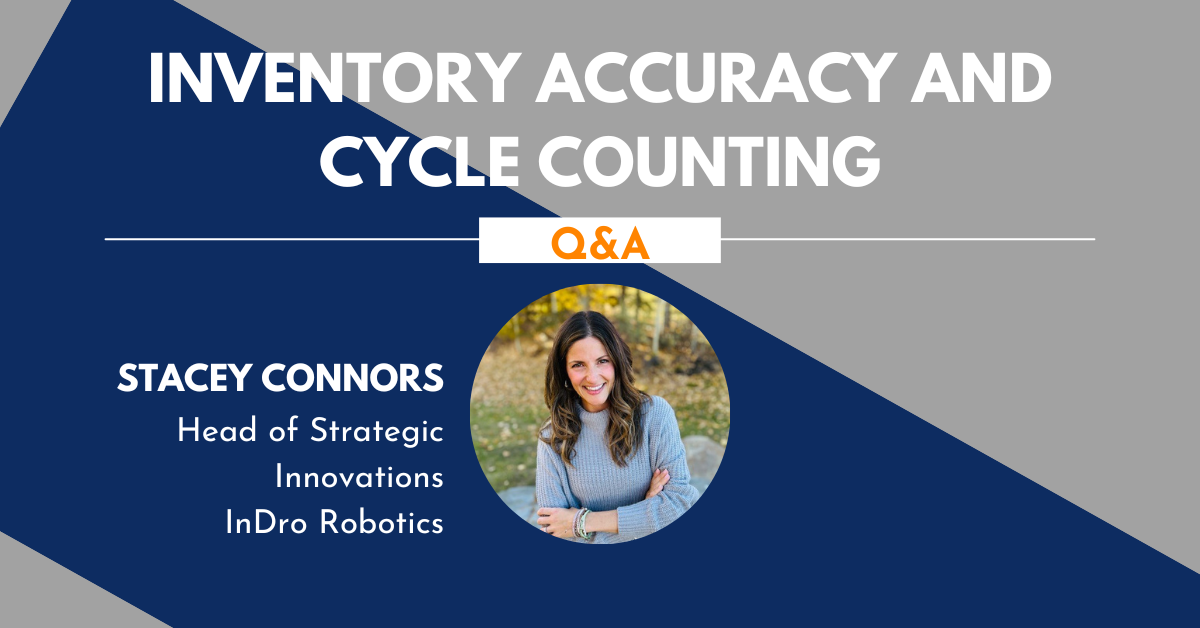


We sat down with Stacey Connors, Head of Strategic Innovations at InDro Robotics, to talk inventory accuracy, warehouse labor retention and their new AMR-tethered drone. She shares best practices for cycle counting and the key to maximizing ROI from robotic automation.
Following post-secondary with a student loan in my mind, I worked with a headhunter who connected me to a magnetic leader at one of the largest global supply chain companies. Without any deep understanding of the industry, I decided to give it a try solely because of the incredible leaders at the company. It can often take someone far ahead of you to see something inside yourself that you didn’t know was there. This leader recognized that my energy and attitude would thrive in this environment. Fast forward 15 years in the industry, there have been two constants that kept me engaged: first, the complexity of the problems we’re solving for organizations, and second, the high-quality leaders I am able to work alongside each and every day.
Warehouses are dealing with the high labor costs associated with completing manual cycle counts as well as the impact on inventory accuracy with limited count coverage and human error. In turn, a lack of confidence in inventory records limits the utilization of the data to drive strategic business insights.
And to be honest, cycle counting is a mundane job, so labor attrition is another issue. There’s also the challenge of equipment availability, as forklifts are required to physically count upper-level racking.
For 3PLs specifically, SLAs around inventory accuracy and the frequency of physical counts bear significant operational costs to maintain. In order to ensure communication and visibility of 99.9% accuracy to their clients, a shocking number of labor hours each month are designated to manual counts. For example, a 1.2M sq ft facility with monthly counts of 29,000 bin locations across three eight-hour shifts.
To position for profitable and sustainable growth, inventory accuracy is paramount. Organizations are recognizing the power of live and accurate inventory data to drive complex business changes. The data is needed to open additional revenue streams, optimize the square footage of facilities and maintain healthy operational margins.
Every organization wants complete confidence in inventory counts daily, but few can financially justify the labor costs associated. With CAPTIS, a single device can autonomously cover a full 1M sq ft warehouse, empowering organizations with the desired confidence in inventory.
Big picture, organizations can unlock opportunities in new revenue streams through participating in connected inventories, as well as utilize the daily inventory data to develop predictive insights with AI.
Not only are there big picture benefits but immediate positive impacts on operational margin. CAPTIS provides a payback on day one with improved accuracy and complete elimination of labor associated with cycle counting.
Long term, CAPTIS provides the valuable data needed to position a company for future growth.
Most Fortune 500 companies explored cycle counting by drone a few years back, concluding that the drone-only technology provided a limited run time of 15-20 minutes, resulting in an unjustifiable payback. CAPTIS, the autonomous mobile robot (AMR) tethered drone solves these limitations, offering 5+ hrs of run time, maximizing coverage with a single device.
Additionally, this AMR-based technology provides greater stability and reliability for autonomy, charging, and lifespan.
Cycle counting is a tough task for humans – it requires careful attention to detail and it’s extremely repetitive. CAPTIS addresses both issues, demonstrating how automation can be used to improve work environments and processes at the same time.
GreyMatter is a game-changer in optimizing a single bot for any size facility – no matter how large. The intelligence behind the software enhances the routing of bots like CAPTIS so customers can get the most out of them.
Without GreyMatter, a single device can still be scheduled for regular mapped counts, but with this driving engine, the device can also be triggered for actions like exception resolution, auditing putaways, auditing inbound pallets, auditing high-turn SKUs, and running client-requested counts for specific SKUs or products.
Additionally, GreyMatter stores the images CAPTIS takes of each location and makes them available for centralized exception management, further reducing the manual functions associated with inventory reconciliation.
RELATED READ: What is Results-Driven Robotics?
Partnering with GreyOrange at Modex was nothing short of powerful. It was immediately obvious that they are an integral partner to most of the Fortune 100 organizations, demonstrating a deep understanding of their operations and needs.
The conversations with their clients exemplified the true flexibility of their software as a wide variety of workflow scenarios were being addressed.
The GreyOrange team members and their clients immediately recognized the impact CAPTIS would have on operational margin, understanding firsthand the challenges and costs related to inventory accuracy.
GreyMatter solves a critical piece of the puzzle for both the client and warehouse robotic providers like Cypher Robotics – the software takes any advanced automation and optimizes the technology, significantly increasing the ROI a customer will experience from their investment in any autonomous robotics solution.